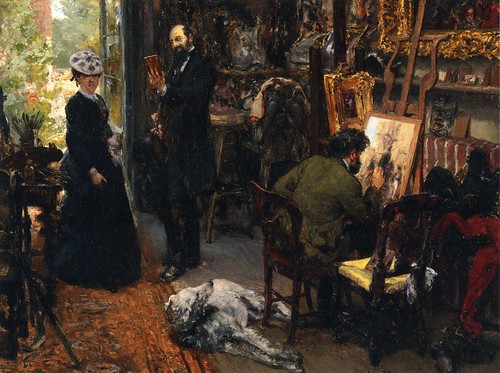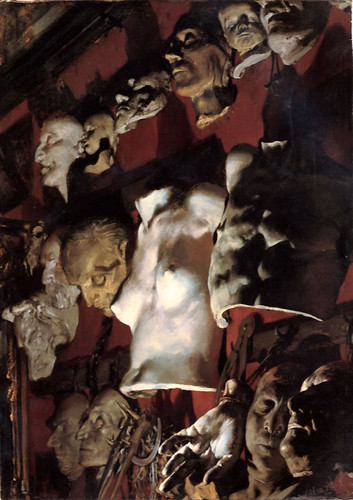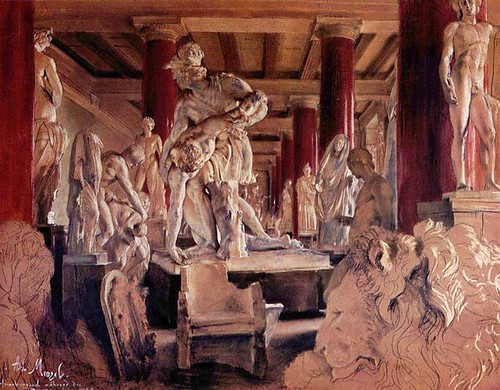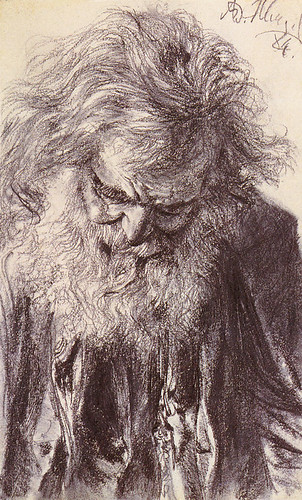“Not a day without drawing,” was a motto often repeated by Menzel and recalled by his students at the Royal Academy of Art in Berlin.

Portrait of Adolf von Menzel (a. 1880) Image published in Newcomb, A; Blackford, K.M.H.: Analyzing Character, 1922. Photographer Paul Thompson.
Adolf von Menzel (Polish/German, 1815-1905) The Artist’s Sister, Emille, Sleeping (c. 1848). Oil on paper. 46 BY 60CM. Kunsthalle, Hamburg.
Menzel was born in Breslau, Poland. In 1830, his father moved the family to Berlin and founded a lithgraphy business, in which Menzel worked from the age of fourteen.
Adolf von Menzel (Polish/German, 1815-1905) View from a window in the Marienstrasse (1867) Gouache over chalk. Oskar Reinhart Foundation, Winterthur.
Shortly after moving to Berlin, Menzel’s father died unexpectedly leaving a young Menzel as the sole provider for the family. Eventually, Menzel was able to involve other members of the family in the business and pursue an education and career in art.
Adolf von Menzel (Polish/German, 1815-1905) A Study of Castes. Oil on canvas. Private collection.
He accepted at the prestigious Royal Academy of Art, where he was discovered by a wallpaper magnate, Carl Heinrich Arnold, who would be become Menzel’s patron, promoter, and friend.
His graduation from the Academy was followed by a series of lithographic commissions, including works by Goethe and a history of the Frederick the Great.

Adolf von Menzel (Polish/German, 1815-1905) Meissonier in his studio at Poissy (1869) Oil on panel. 8 1/4 BY 11 3/8IN. Private collection.
In 1855, Menzel traveled to Paris for the first time. The occasion was most likely the influential Paris Exposition Universelle, with thousands of artists’ works on display in series of pavilions organized by nationality. There Menzel saw Gustave Courbet’s “Pavillon du Réalism,” which led to a more naturalistic approach to his paintings. From that time forward, he would make regular trips to Paris and came to know some of the city’s most important artists.
Adolf von Menzel (Polish/German, 1815-1905) Aufbewahrungssaal während des Museumsumbaus (1848) Pastel on paper. 46 BY 57CM. Alte Nationalgalerie, Berlin.
By the end of his life, Menzel was considered one of Berlin’s greatest artists. He joined the Royal Academy of Art in 1853, and was a teacher at the school from 1875 until his death in 1905. He had been decorated as a Knight of the Black Order, given the rank of Privy Councilor with the title “Your Excellency,” and awarded an honorary doctorate at the University of Berlin.
This gave him a crowd of admirers and friends within government and other circles; in fact, one of his closest friends was the composer Johannes Brahms.
Adolf von Menzel (Polish/German, 1815-1905) Portrait of an Old Man (1884) Pencil on paper. 8 1/2 BY 5IN. Private collection.
Internationally, he had been honored with a show dedicated to his work in Paris in 1884, and was granted membership at the Royal Academies of London, St. Petersburg, and Paris. His works regularly appeared in the Paris Salon until his death.





These paintings are so brushy! Not terribly Mid-century academic in that way, do you think?
In fact kind of like the E. Roesler Franz cityscapes of Rome, of the famous “Roma Sparita” series — you must like those too.
I really like E. Roesler Franz, and would never have made that connection. Now that you point it out, they have a lot of similarities in tonality and treatment of the figure. Where Franz paints the 10,000-foot view, Menzel paints the intimate, 10-foot version.
About their “brushy”-ness, I believe it has to do with a few factors. First, the images I chose were mainly drawings, chalk, gouache, or oil on paper. (I added two more paintings just a moment ago.) With those media, it’s hard to get a finished surface like that of an oil on canvas or oil on board and, therefore, regardless of the painter, will most often reveal more of the artist’s stroke. Second, ant-academic and pro-impressionist art historian often like to say that one of the reasons the Impressionists didn’t get along with the academic painters was because their paintings didn’t look glassy and showed their strokes. This assumes that all academic painters had glassy finishes, which isn’t true.Breton, Meissonier, and Old Maters like Titian and Velázquez regularly showed their brush strokes. To be fair, and for the last point, Menzel was not a hardcore academician, though he taught at the Academy in Berlin. He was more of a realist. The verisimilitude of his work required a kind of ambiguity that a classicist working in the ideal would change.
[…] The painting featured on the cover a pastel and charcoal drawing on paper by the artist Adolf von Menzel (Polish/German, 1815-1905), recently featured on this blog. […]